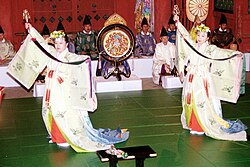神楽鈴
Appearance
Japanese
[edit]
| Kanji in this term | ||
|---|---|---|
| 神 | 楽 | 鈴 |
| か Grade: 3 |
らく > ぐら Grade: 2 |
すず Grade: S |
| irregular | kun'yomi | |
| Alternative spelling |
|---|
| 神樂鈴 (kyūjitai) |
Etymology
[edit]Compound of 神楽 (kagura, “divine entertainment”) + 鈴 (suzu, “bell”).[1][2][3]
Pronunciation
[edit]Noun
[edit]神楽鈴 • (kagura suzu)
- a three-tiered set of bells suspended by coiled brass wires on a hand-held rod used in the kagura dances by miko.
- The inspiration for the shape of the bells is thought to have been the fruits of the ogatama tree (小賀玉の木, 黄心樹, 招霊の木, オガタマノキ (ogatama no ki): Magnolia compressa).
References
[edit]- ^ Shōgaku Tosho (1988) 国語大辞典(新装版) [Unabridged Dictionary of Japanese (Revised Edition)] (in Japanese), Tōkyō: Shogakukan, →ISBN
- ^ Matsumura, Akira (1995) 大辞泉 [Daijisen] (in Japanese), First edition, Tokyo: Shogakukan, →ISBN
- ↑ 3.0 3.1 Matsumura, Akira, editor (2006), 大辞林 [Daijirin] (in Japanese), Third edition, Tokyo: Sanseidō, →ISBN
Categories:
- Japanese terms spelled with 神
- Japanese terms spelled with 楽
- Japanese terms spelled with 鈴 read as すず
- Japanese terms read with irregular kanji readings
- Japanese compound terms
- Japanese terms with IPA pronunciation
- Japanese lemmas
- Japanese nouns
- Japanese terms with multiple readings
- Japanese terms spelled with third grade kanji
- Japanese terms spelled with second grade kanji
- Japanese terms spelled with secondary school kanji
- Japanese terms with 3 kanji
- ja:Percussion instruments

